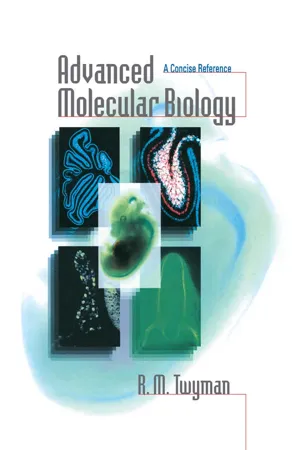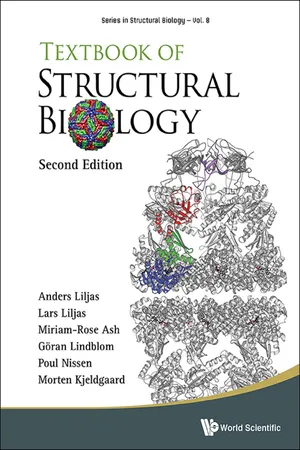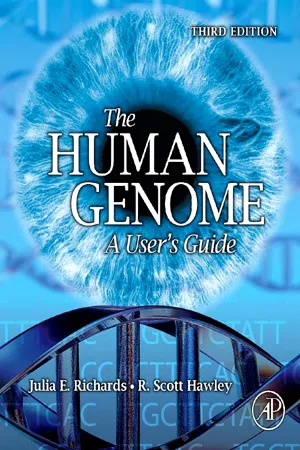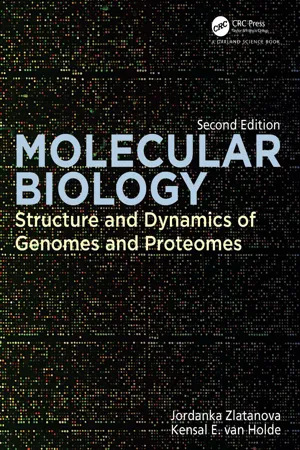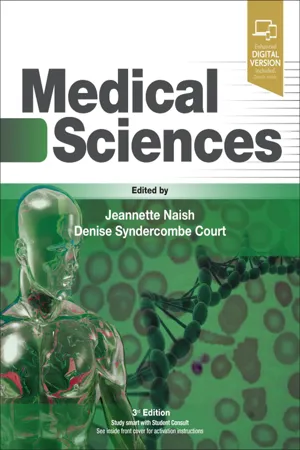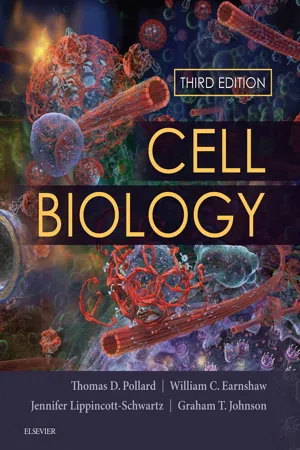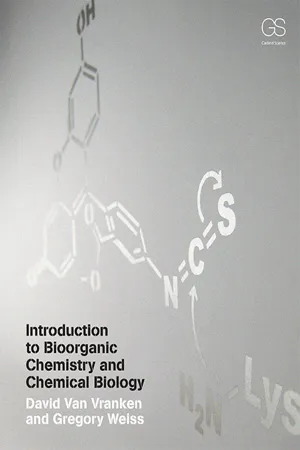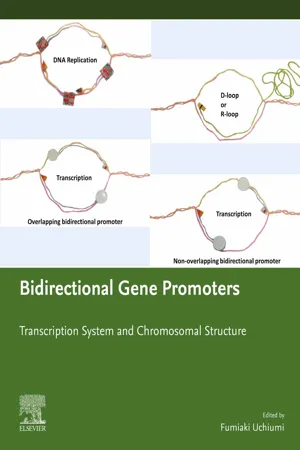Biological Sciences
rRNA, tRNA and mRNA
rRNA, tRNA, and mRNA are three types of RNA molecules involved in protein synthesis. Ribosomal RNA (rRNA) forms the structure of ribosomes, transfer RNA (tRNA) carries amino acids to the ribosome, and messenger RNA (mRNA) carries genetic information from the DNA to the ribosome for protein synthesis. Each type of RNA plays a crucial role in the process of translation.
Written by Perlego with AI-assistance
Related key terms
12 Key excerpts on "rRNA, tRNA and mRNA"
- eBook - ePub
Advanced Molecular Biology
A Concise Reference
- Richard Twyman(Author)
- 2018(Publication Date)
- Garland Science(Publisher)
rRNA makes up 60–65% of the total mass and is essential for structural integrity and function, adopting complex tertiary and quaternary conformations by intra- and intermolecular base pairing. The manner in which proteins interact with the RNA and each other within this network has been studied in great detail for the E. coli ribosome using cross-linking and footprinting studies, and structural analysis by neutron scattering and diffraction. Although the primary nucleic acid sequences of rRNAs from different species vary considerably, it appears that most of the secondary structures are conserved, suggesting that all ribosomes share a common organization. Several domains of the ribosome have particularly important functions during protein synthesis. The small subunit contains a binding site for mRNA and two major binding sites for tRNA. The A-site (amino acyl-tRNA site) binds incoming charged tRNAs during elongation, whilst the P-site (peptidyl-tRNA site) binds the tRNA carrying the nascent polypeptide chain. Bacterial ribosomes possess a third E-site (exit site) to which spent tRNAs are dispatched prior to ejection. The large sub-unit possesses a petidyltransferase domain, which provides the catalytic activity for peptide bond formation, and a GTPase domain, whose activities are required for translocation of the ribosome along the mRNA. The roles of these sites during protein synthesis are discussed in more detail below. Transfer RNA. Before the genetic code (q.v.) was understood, Francis Crick proposed the adaptor hypothesis to explain how the nucleotide sequence in mRNA could be translated into protein - eBook - ePub
- Anders Liljas, Lars Liljas;Miriam-Rose Ash;G?ran Lindblom;Poul Nissen;Morten Kjeldgaard(Authors)
- 2016(Publication Date)
- WSPC(Publisher)
An important aspect of protein synthesis is that nucleic acid molecules have central roles, in contrast to most other processes in cells where proteins dominate. Central components are the mRNA, the tRNA and the ribosomal rRNA molecules. An mRNA molecule contains a copy of the gene sequence and binds to the ribosome. The tRNA molecules, the adapters suggested by Francis Crick, decode the gene sequence and link the amino acid into the growing peptide on the ribosome.Fig. 11.1 ▪ The universal genetic code. The trinucleotide codons are translated to the 20 amino acids, given here with their three and one letter codes.11.1.1The Genetic Code and the tRNAs
The base triplets of the genetic code (Figure 11.1 ) that build up a messenger rRNA (mRNA) are called codons and correspond to the 20 different amino acids. In addition, there are normally three stop codons (UAA, UAG and UGA). The synthesis of a protein normally starts at an AUG codon, which is also the codon for methionine. Special systems have developed to differentiate between ordinary methionine codons and the start signal, the initiation codon. In some cases (methionine, tryptophan), there is only one triplet that codes for a certain amino acid, but sometimes there are as many as six (serine, leucine, arginine). The code is degenerate. There is no one-to-one relationship between codons and tRNA molecules. Mammalian mitochondria have a very limited set of tRNA molecules, but many species have around 40. This relates to the variable codon usage as well as to the capacity of some tRNAs to read several codons (tRNA wobble base-paring).The tRNA molecules are normally around 75 nucleotides long (Section 5.3.10.1 ). The secondary structure looks like a cloverleaf with a stem and three leaves (Figure 5.47 ). The stem has the unique sequence CCA at the 3′-end. It is the ribose of the 3′-terminal A that gets aminoacylated by specific enzymes, tRNA synthetases. This stem is therefore called the aminoacyl or acceptor stem. The three leaves or arms of the tRNA are called the D stem and loop, the anticodon stem and loop, and the T stem and loop, respectively. In addition, there is a variable loop (V-loop) that can be upto 21 nucleotides in length. Serine and leucine tRNAs generally have long V-loops as does tyrosine tRNA in bacteria and chloroplasts. The anticodon at the end of the middle loop can match a codon in the mRNA. The three-dimensional structure of the tRNA molecule has the shape of an “L” (Figure 5.47 - eBook - ePub
- Julia E. Richards, R. Scott Hawley(Authors)
- 2010(Publication Date)
- Academic Press(Publisher)
60–300 bases. Help with chemical modification of rRNAs, tRNAs, and snRNAsMicro RNAmiRNA~21–22 bases. Single-stranded RNA binds to the 3′ untranslated region of a specific mRNA to block translationSmall interfering RNA20–25 bases. Double-stranded RNA becomes part of the silencing complex that degrades targeted RNAs that are homologous to the siRNAIn some cases RNA is a structural molecule that carries out functions that the cell needs. Some of the most important examples of structural RNAs are the ribosomal RNAs. These RNAs combine with ribosomal proteins to make up the ribosomes. When the cell is metabolically active it needs a lot of ribosomes to be able to make the many kinds of proteins being used by the cell. Thus an actively dividing cell transcribes ribosomal RNA very actively (Figure 3.6 ), at such a high rate that it causes the region called the nucleolus to be visibly distinct within the nucleus.Figure 3.6 Transcription of RNA is carried out very actively in a cell that is getting ready to divide. The genes are organized in a cluster, and a new transcript from a gene begins before the previous transcript has been completed. The result is a cluster of RNA molecules that appear to stream from the chromosome like branches on an evergreen tree. The chromosome is the vertical line from which the branches radiate.(Image by Professor Oscar Miller/Science Photo Library. © All rights reserved.)In other cases, RNA serves as an enzyme, a type of molecule that catalyzes a chemical reaction. An example of an important class of enzymatic RNA would be those RNAs that play a role in splicing of other RNA molecules.Some RNAs are part of a composite molecule that combines some RNA with some other types of molecules such as proteins or a given amino acid. A good example would be the transfer RNA, or tRNA (Figure 3.5 ), that forms a composite molecule consisting of an RNA molecule with an amino acid fastened to it. As we will discuss in Chapter 4 - Tina M. Henkin, Joseph E. Peters(Authors)
- 2020(Publication Date)
- ASM Press(Publisher)
anticodon that is complementary to the codon in the mRNA. The base-pairing rules for codons and anticodons are basically the same as the base-pairing rules for DNA replication, and the pairing is antiparallel. The only major differences are that RNA has uracil (U) rather than thymine (T) and that the pairing between the last of the 3 bases in the codon and the first base in the anticodon is less stringent.This basic outline of gene expression leaves many important questions unanswered. How does mRNA synthesis begin and end at the correct places and on the correct strand in the DNA? Similarly, how does translation start and stop at the correct places on the mRNA? What actually happens to the tRNA and ribosomes during translation? What happens to the mRNA and proteins after they are made? The answers to these questions and many others are important for the interpretation of genetic experiments, so we will discuss the structure of RNA and proteins and the processes by which they are synthesized in more detail.The Structure and Function of RNA
In this section, we review the basic components of RNA and how it is synthesized. We also review how structure varies among different types of cellular RNAs and the role each type plays in cellular processes.Types of RNA
There are several different classes of RNA in cells. Some of these, including mRNA, rRNA, and tRNA, are involved in protein synthesis. Each of these types of RNA has special properties, which are discussed below. Others are involved in regulation, replication, and protein secretion.RNA Precursors
RNA is similar to DNA in that it is composed of a chain of nucleotides. However, RNA nucleotides contain the sugar ribose instead of deoxyribose. These five-carbon sugars differ in the second carbon, which is attached to a hydroxyl group in ribose rather than the hydrogen found in deoxyribose (see Figure 1.2 ). Figure 2.1A shows the structure of a ribonucleoside triphosphate (rNTP), which is the form that is used as a precursor during RNA synthesis.RNA and DNA chains also vary in the bases that are present. Three of the bases—adenine, guanine, and cytosine—are the same, but RNA has uracil instead of the thymine found in DNA (Figure 2.1B- eBook - ePub
Molecular Biology
Structure and Dynamics of Genomes and Proteomes
- Jordanka Zlatanova(Author)
- 2023(Publication Date)
- Garland Science(Publisher)
Translation: The PlayersDOI: 10.1201/9781003132929-15Learning objectivesTranslation is the process by which messenger RNA chains are read to yield protein chains. Translation requires both RNA–RNA and RNA–amino acid recognition. The three major players in translation are the mRNA that carries the message, the tRNA (adaptor) molecules that carry the amino acid specified by the next codon in the mRNA, and the ribosome, the active platform on which the process occurs.tRNA molecules carry both an anticodon that matches the codon on the message and the amino acid that is specified by that codon. The charging of tRNAs with amino acids is catalyzed by a set of enzymes called aminoacyl-tRNA synthetases. In this two-step process, the amino acid is first activated by adenylation and then attached to the acceptor end of the corresponding tRNA. Various modes of proofreading ensure the fidelity of matching the amino acid with the appropriate tRNA.Functional ribosomes in all cells are composed of two subunits, designated by their sedimentation coefficients: 30S and 50S subunits give rise to 70S ribosomes in bacteria and archaea, while 40S and 60S subunits form 80S ribosomes in eukaryotes. Each ribosome contains several RNAs and many proteins, which form three tRNA-binding sites shared between the large and small subunit. During elongation, tRNA is transferred between these sites in a unidirectional manner. Ribosome biogenesis is a complicated multistep process that requires coordinated synthesis of several RNA molecules and the whole set of ribosomal proteins. Assembly of eukaryotic ribosomes requires additional RNA processing and auxiliary protein factors.Initiation of translation occurs via different mechanisms in bacteria and eukaryotes. Bacteria use a special sequence (known as the Shine–Dalgarno, SD, sequence) located near the 5′-terminus of the mRNA: SD base-pairs with a sequence in the 16S rRNA of the small ribosomal subunit. In eukaryotes, the ribosome attaches near the cap and hunts downstream for the first methionine codon. Finally, termination of translation involves both specific stop codons and termination factors that bind to the ribosome instead of tRNAs. - Naoki Sugimoto(Author)
- 2021(Publication Date)
- Wiley-VCH(Publisher)
7 TranslationThe main points of the learning- Study basic molecular mechanisms of translation reaction.
- Understand presence of various reaction steps for translation modulation and maintenance.
- Study contributions of RNA structures to the translation modulation.
7.1 Introduction
Protein is biopolymer consisting of amino acids polymerized in one dimension. In living system, the amino acid sequence of each protein is encoded in the sequence of messenger RNA (mRNA) that is originally encoded in DNA sequence. The sequence code on mRNA is decoded by a ribosome though a reaction termed translation. Since the protein is the main functional molecule in extant living system, translation is one of the most important biological reactions. Intracellular protein expression is modulated at not only transcription level but also at translation level. The formation of unique RNA structures and their dynamic behaviors are the key factors to modulate and maintain the translation system. This chapter describes contribution of RNA structures on translation reaction as well as its basic knowledge. The contributions of structure dynamics of RNAs on gene expressions including replication, transcription, and translation are described in Chapter 10 .7.2 RNAs Involved in Translation Machinery
There are three categories of RNAs such as mRNA, tRNA, and rRNA, which are directly involved in translation machinery. mRNA is a template for the translation. A region of nucleotide sequence in mature mRNA that is translated to a given protein is known as an open reading frame (ORF) (Figure 7.1 ). Correlation between nucleotide sequence and amino acid sequence was first proposed by Francis Crick as a sequence hypothesis. George Gamow, who is a theoretical physicist and cosmologist famous for his big bang theory, proposed that specific trinucleotide encodes one specific amino acid. The trinucleotide, which encodes a specific amino acid, is now known as a codon. Correlations between each codon and amino acid, which are conserved in all extant living system with few exceptions, have resolved by contributions from Marshall Nirenberg and Har Khorana (Figure 7.2 ). Outside of coding sequence, mRNA contains noncoding sequences. Untranslated regions (UTRs) at 5′ and 3′ ends of mRNA are called 5′ UTR and 3′ UTR, respectively. Prokaryotic mRNAs are polycistronic, which contains multiple ORFs in one mRNA. There are noncoding sequences between adjacent ORFs. In the case of eukaryotic mRNAs, primary transcript is a precursor messenger RNA (pre-mRNA) consisting of alternating exon and intron regions. Noncoding introns are excluded by posttranscriptional splicing that result in connected exons as a mature mRNA (Figure 7.1- eBook - ePub
- Jeannette Naish, Denise Syndercombe Court, Jeannette Naish, Denise Syndercombe Court(Authors)
- 2018(Publication Date)
- Elsevier(Publisher)
Small nuclear RNAs (snRNAs) and small nucleolar RNAs (snoRNAs) are involved in mRNA and rRNA processing and maturation within the nucleus, respectively. Small cytoplasmic RNAs (scRNAs) are components of the spliceosome, a complex containing small ribonucleoprotein particles (snRNPs) that removes intron sequences from precursor mRNA. The splicing apparatus contains RNA and proteins, and it assembles on mRNA.- • Micro RNAs (miRNAs ) including small interfering RNA (siRNA) participate in the regulation of gene expression.
miRNAs are single-stranded non-coding RNAs 20–25 nucleotides long. They downregulate gene expression through mRNA cleavage and deadenylation, as well as through repression of the translation which involves a multiprotein RNA-induced silencing complex (RISC). siRNA is double stranded.Secondary structure of RNA
Most RNA molecules are single-stranded. Parts of the molecule can form loops or hairpins between complementary regions of its single strand. The tRNAs have a cloverleaf shape with four stem-loops, each of which forms a short double helix ( Fig. 2.19 ) .Fig. 2.19 General structure of tRNA.Amino acids
Amino acids are the structural units of proteins. They contain short hydrocarbon chains of variable length, oxygen atoms and nitrogen. Apart from being incorporated into proteins, amino acids are precursors of nucleosides, neurotransmitters and haem, among many other molecules (Ch. 3 ) (Clinical box 2.5 ).Clinical box 2.5Errors in amino acid metabolismWhen the metabolism pathway of an amino acid is disrupted, its precursors may accumulate in the blood or appear in the urine (normally, most amino acids are reabsorbed in the kidney proximal tubules). Thus, measurements of serum and urine levels have diagnostic significance in the detection of inborn errors of metabolism.For example, in phenylketonuria (PKU), where there is a deficiency of phenylalanine hydroxylase (or two other enzymes in the same pathway), and there is accumulation of the intermediate metabolites phenylacetate, phenylacetylglutamine and phenylpyruvate. Untreated PKU leads to brain damage (Chs 3 and 5 - eBook - ePub
Advanced Chemical Biology
Chemical Dissection and Reprogramming of Biological Systems
- Howard C. Hang, Matthew R. Pratt, Jennifer A. Prescher, Howard C. Hang, Matthew R. Pratt, Jennifer A. Prescher(Authors)
- 2023(Publication Date)
- Wiley-VCH(Publisher)
4 RNA Function, Synthesis, and Probing Andreas Pintado‐Urbanc1 ,2and Matthew D. Simon1 ,21 Department of Molecular Biophysics and Biochemistry, Yale University, 266 Whitney Ave, New Haven, CT, 06511, USA 2 Institute of Biomolecular Design and Discovery, Yale University, 600 West Campus Dr, West Haven, CT, 06516, USA4.1 Introduction
How did life begin? There is ample evidence to support the hypothesis that life began with an RNA world [1] . RNA has the capacity to both encode information in its primary sequence and to perform complex functions (plausibly including self‐replication). This is because of its ability to fold into intricate three‐dimensional structures. Relics of the RNA world can be found throughout the pantheon of biomolecules, notably through the prevalence of ribonucleotides in cofactors, such as adenosine triphosphate (ATP ), nicotinamide adenine dinucleotide (NAD+), and acetyl‐CoA. In modern life, RNA is at the heart of the central dogma of molecular biology, enabling the sequential flow of genetic information (DNA → RNA → protein). Additionally, RNA carries out a broad range of biological functions beyond coding for proteins. As will be explored in Chapters 4 and 5 , the chemical biology of RNA is central to the study and manipulation of biology, especially regulated gene expression. In this chapter, we will explore the chemical properties and principles of RNA molecules. Chapter 5 will extend this exploration to the regulatory roles of RNA in gene expression.The chemistry and biology of RNA are often closely aligned with that of DNA, the fundamental principles of which are described in Chapter 3 . As nucleotide chemistries are frequently portable, RNA chemical synthesis (Section 4.4.1 ) and sequencing strategies (Section 4.5 - eBook - ePub
- G Michael Blackburn, Michael J Gait, David Loakes, David M Williams, Jane A Grasby, Stephen Neidle, G Michael Blackburn, Michael J Gait, David Loakes, David M Williams(Authors)
- 2015(Publication Date)
- Royal Society of Chemistry(Publisher)
CHAPTER 7 RNA Structure and FunctionCONTENTS 7.1 RNA Structural Motifs 7.1.1 Basic Structural Features of RNA 7.1.2 Base Pairings in RNA 7.1.3 RNA Multiple Interactions 7.1.4 RNA Tertiary Structure 7.2 RNA Processing and Modification 7.2.1 Protecting and Targeting the Transcript: Capping and Polyadenylation 7.2.2 Splicing and Trimming the RNA 7.2.3 Editing the Sequence of RNA 7.2.4 Modified Nucleotides Increase the Diversity of RNA Functional Groups 7.2.5 RNA Removal and Decay 7.3 RNAs in the Protein Factory: Translation 7.3.1 Messenger RNA and the Genetic Code 7.3.2 Transfer RNA and Aminoacylation 7.3.3 Ribosomal RNAs and the Ribosome 7.4 RNAs Involved in Export and Transport 7.4.1 Transport of RNA 7.4.2 RNA that Transports Protein: the Signal Recognition Particle 7.5 RNAs and Epigenetic Phenomena 7.5.1 RNA Mobile Elements 7.5.2 SnoRNAs: Guides for Modification of Ribosomal RNA 7.5.3 Small RNAs Involved in Gene Silencing and Regulation 7.6 RNA Structure and Function in Viral Systems 7.6.1 RNA as an Engine Part: The Bacteriophage Packaging Motor 7.6.2 RNA as a Catalyst: Self-Cleaving Motifs from Viral RNA 7.6.3 RNA Tertiary Structure and Viral Function References7.1 RNA STRUCTURAL MOTIFS
RNA is the most versatile macromolecule in nature. The linear sequence of an RNA can encode large amounts of complex information that is subsequently transformed into functional proteins. However, many RNA sequences also contain sufficient information to fold themselves into specific shapes with distinct chemical properties. Thus, RNA is unique amongst biopolymers in that it encodes genetic information, provides structural scaffolding, recognizes and transports other molecules, and carries out many forms of chemical catalysis in the cell. - eBook - ePub
- Thomas D. Pollard, William C. Earnshaw, Jennifer Lippincott-Schwartz, Graham Johnson(Authors)
- 2016(Publication Date)
- Elsevier(Publisher)
The rRNAs fold into many based-paired helices, as first predicted by comparing the sequences of rRNAs from many different species (Fig. 12.6). These helices and their intervening loops pack to form a compact structure. Although prokaryotic rRNAs differ in size and sequence from eukaryotic rRNAs, they fold similarly. Many features of rRNAs have been conserved during evolution, including the surfaces where subunits interact, the sites for binding tRNA, mRNA, and protein cofactors, and the nucleotides involved with peptide bond formation. Most ribosomal proteins associate with the surface of the rRNA core, although several extend peptide strands into the core (Fig. 12.7). Ribosomal proteins are generally small (10 to 30 kD) and basic. With one exception, ribosomes have just one copy of each protein. Decoding of mRNAs and polypeptide synthesis take place in the cavity between the subunits. The surfaces of this cavity are generally free of proteins, so (amazingly) rRNAs—not proteins—are largely responsible for mRNA binding, tRNA binding, and catalysis of peptide bond formation. tRNAs move sequentially through three sites shared by the two subunits: the A site (aa-tRNA), the P site (for peptidyl-tRNA), and the E site (for exit). The growing polypeptide chain exits in a tunnel that passes through the RNA core of the large subunit. The synthesis and assembly of a yeast ribosome requires the participation of all three RNA polymerases, 75 small nucleolar RNAs (snoRNAs), and more than 200 protein factors, in addition to the 80 ribosomal proteins and 4 rRNAs present in the mature ribosomes. Precursor RNAs are cleaved and modified to form the rRNAs (see Fig. 11.10) - David Van Vranken, Gregory A. Weiss(Authors)
- 2018(Publication Date)
- Garland Science(Publisher)
RNA 4Learning Objectives
- Understand the chemical and structural differences between RNA and DNA.
- Describe the features of a DNA gene sequence that determine when genes will be expressed and what part of the gene will be transcribed.
- Draw a scheme showing the synthesis, processing, and translation of RNA in eukaryotic cells.
- Explain how RNA interference can be used to control gene expression in cells.
- Describe the features of an mRNA sequence that control ribosomal binding and what part of the mRNA will be translated.
- Explain the role of tRNA and elongation factors in translation.
- Describe the steps needed to produce a combinatorial library of proteins.
P hoebus Aaron Theodore Levene () studied both RNA and DNA, and contributed key insights into the structures of both biopolymers. When Levene began his research at the Rockefeller Institute for Medical Research, precipitation techniques had been used to isolate two different types of nucleic acids—one from yeast and the other from calf thymus. In 1909, Levene showed that the carbohydrate in the nucleic acids isolated from yeast was the pentose sugar ribose, correctly identifying the material from yeast as RNA. Twenty years later, Levene also correctly identified the equivalent carbohydrate in material extracted from calf thymus as deoxyribose. Additionally, Levene deduced key structural elements of nucleic acids; for example, he coined the term “nucleoside” to describe a carbohydrate linked through a glycosidic bond to the base of a nucleic acid. With tour de force experimentation, he also discovered that the phosphodiesters link to the 3ʹ and 5ʹ carbons of the nucleic acid carbohydrate. Thus, Levene earned a spot in the pantheon of chemical biology through key insights into the chemical structures of RNA and DNA.Figure 4.1When Francis Crick first proposed the central dogma in 1956, RNA was considered a minor league player charged merely with transducing information. The attentions of biochemists remained firmly fixed on DNA and proteins. However, information about and appreciation for the myriad roles of RNA have exploded over the past 25 years. RNA molecules assume diverse roles in the cell, including courier, craftsman, interpreter, and sentry. Given the chemical similarity between DNA and RNA, it may seem strange that DNA is assigned one principal role while RNA is assigned many diverse roles. The great agility of cellular RNA relative to cellular DNA is principally due to the fact that RNA is single-stranded, and any single-stranded oligonucleotide will tend to hybridize with itself to form a three-dimensional shape. In contrast, cellular DNA is generally double-stranded, leading to a monotonous unidimensional form.- eBook - ePub
Bidirectional Gene Promoters
Transcription system and chromosomal structure
- Fumiaki Uchiumi(Author)
- 2022(Publication Date)
- Elsevier(Publisher)
+ molecules could be polymerized to generate fatty acids, polysaccharides, polypeptides, and poly(ADP-ribose)s. These biological polymers failed to become genetic materials but contributed towards other biological purposes. We could easily understand that RNAs have been the most advantageous within these molecules, carrying the genetic information and biological functions or primitive enzymatic activities. They might have replicated from the ribonucleotide sequences to complimentary ribonucleotide sequences with the help of a biological catalyst, which might have been RNA polymers. If life emerged from the RNA world, all the RNA molecules were non-coding, because functional proteins were probably not present. At that time, even if RNAs were not coding amino acids, that was alright. Presently, in both prokaryotic and eukaryotic cells, protein coding RNAs or mRNAs are the minority, consisting of only several percent among the total RNAs. Most of the RNAs are rRNAs and tRNAs. In this regard, is it not just a little bit strange if we call the non-mRNAs the “non-coding RNAs”? Because during the chemical evolution, RNAs originally have not been necessary to code amino acid sequences. RNAs are essentially non-coding from the beginning.The term “non-coding” seems to have come from non-coding DNAs, which represent specific genomic regions to be transcribed, but not encoding functional amino acid sequences. In this chapter, following convention, non mRNAs/hnRNAs are referred to as non-coding RNAs. They include rRNAs, tRNAs, small nuclear RNAs (snRNAs), micro RNAs (miRNAs) [1] , circular RNAs (circRNAs) [2 , 3] , and long non-coding RNAs (lncRNAs) [4 , 5] .In accordance with the innovational progress in molecular biology or nucleotide-sequence analyzing technology, genomic databases of human and other organisms have been continuously updated. Thanks to ENCODE [6] , GENCODE [7] and FANTOM [8] projects, non-coding RNAs and small/short RNAs, which have been previously taken as junk RNAs to be discarded, were identified one after another and re-evaluated to be registered on human genome DNA databases. In this chapter, I will briefly review biological functions of miRNAs, and lncRNAs, before surveillance of their promoter regions that are head-head bound with other genes. The other ncRNAs to be noticed are enhancer RNAs (eRNAs), which can enhance transcription of specific genes [9] . The eRNA region can frequently be found near or around promoter regions of various genes. As you may speculate, the dysregulation of their expression could lead to human diseases, especially aging-associated diseases, including cancer and neurodegenerative diseases. The essential characteristics and functions of the intergenic enhancers in the mammalian genomes are to be discussed in Chapter 8 .Classification of ncRNAs and relationships with DNA repair, mitochondrial function, and the immune system
Presently, classification of the ncRNAs has been almost completely settled and summarized [10] . However, biological roles or functions of the ncRNAs have been increasingly discussed and it has been revealed that they are quite divergent [4 , 11-13 ]. Among lncRNAs, for example, NEAT1 (nuclear-enriched abundant transcript 1) and MALAT1 (metastasis-associated lung adenocarcinoma transcript 1) are well known to localize at active chromatin [14] , implying that they are playing a role in the regulation of various nuclear events, including transcription. Specific miRNAs are known to regulate stability of mRNAs and translation [15 , 16] . For example, BACE1-AS, which is transcribed to the opposite direction of the BACE1 gene, can stabilize BACE1 transcripts, preventing their degradation [17] . They not only regulate transcription/translation, but also splicing of immature RNAs [18] and chromosomal rearrangement/maintenance/segregation [19 , 20] . Telomerase, which plays an essential role in the elongation of telomeres and thereby maintains the integrity of chromosomes, are known to contain an ncRNA, TERC (TER) [21] . Interestingly, recent studies showed that the TERC is involved in the regulation of immune responses [22] and mitochondrial functions [23 , 24]
Index pages curate the most relevant extracts from our library of academic textbooks. They’ve been created using an in-house natural language model (NLM), each adding context and meaning to key research topics.
